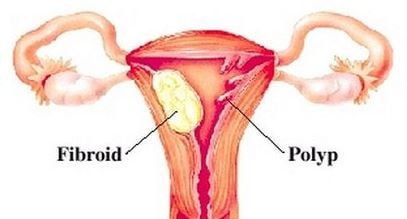Endometrial Polyp
What is endometrial polyp?
The uterus is a muscular organ. The inner layer of the uterus is made up of endometrial tissue, which is enlarged and contract during menstruation. For maintaining the regular menstrual cycle, endometrial tissue becomes shed during period dates and after completion of cycle due to the influence of estrogen hormone the endometrial tissue rapidly growing.

Excessive growths in the endometrial lining cause polyp formation which is quite similar to a shrub or tree like structure. The size varies individual to individual, it may be tiny or medium and even cricket ball size (rarely).
The branch of the polyp is usually small, but sometimes, it has long length due to projected out from the cervix. The incidence rate is quite high in women who are at the age of menopause (above 40 years). The nature of the endometrial polyp is usually benign.
Symptoms of endometrial polyp
The most of the women do not have the prominent symptoms, if the polyp size is tiny. In case of intermediate to larger size of the polyp, following are the usual symptoms:
- Heavy flow of bleeding during periods date
- Flow of blood is not even in each menstrual cycle
- Uneven gap between menstrual cycles. In some months, the starting date of the menstrual period is earlier and in some other month, it will be delayed.
- Bleeding or spotting in between intervals of the menstrual cycle
- Blood spot appeared after intercourse
- After completion of the menstrual cycle, brown blood spotting remain for a few days.
These symptoms arise due to polyps are suspended from their branches and aggravate the associated tissues. This may cause injury to the attached blood vessels and bleeding or spotting from the vaginal route is occurring.
If the location of the polyp hampers the fertilization of egg and sperm by obstructing the fallopian tube, then it can cause infertility or delayed pregnancy, though proper scientific evidence is not yet found. It is also assumed that endometrial polyp influences miscarriage, but not having any evidence. Doctors also suggest removing polyps in case of repetitive miscarriage.
Causes
The following factors are the responsible for development of the endometrial polyps:
- With increasing age
- Increase body wight
- Drug like tamoxifen usages in case of breast cancer
- Hypertension
- Infection is the cervical region
- Chronic swelling at the endometrial layer
- Misbalanced estrogen hormonal level in the female body
- Cervical blood vessels blockage
Diagnosis
The different diagnostic methods are available, following are the usual techniques applied for endometrial polyp detection:
Ultrasounds
Transvaginal ultrasounds can able to visualize the endometrial thickening. But it does not able to discriminate cancerous or non-cancerous polyps. This also helps to identify the focal accumulations at the endometrial passage. The stalks may have a wide or narrow base. The polyp may fill with proteinous fluid which is also identified under transvaginal ultrasonography. For proper identification of the detecting the border line of the polyps, 3D images are preferable.
Saline-infused sonography (SIS)
This tool is also able to enhance the detection of a polyp. This is the beat probability to proper utilization of ultrasound.
Hysteroscopy
These are the best way to diagnose the endometrial polyps. These techniques using color flow or power Doppler for correct diagnosis.
Hysterosalpinography
This is also another option for detecting the endometrial polyps. In this process dye is inserted via the cervix and reaches to the endometrial cavity. This technique is also used ionizing radiation and iodine containing contrast. The disadvantage of the process is an invasive technique which is painful.
Other available diagnostic tools are MRI and CT scan. Comparison with other techniques, MRI is expensive and the CT scan has low sensitivity against endometrial polyps.
Management
It has been identified that almost 1/4th of endometrial polyp can abolish naturally within one year of its development. This is most common with tiny polyps, which have less than 10mm of diameter and also not have direct connection with blood vessel.
For post menopause, most of the women develop polyps, which may need proper identification, as these are cancerous or not. This decision is take after detail discussion of sign and symptoms with affected woman.
Pharmacological treatment
Hormonal treatment is usually comes under pharmacological treatment, though it does not able cure the polyps, but may have the preventive properties for further development of the polyps. Usually, hormonal therapy is available as tablets, pills or intrauterine devices.
Surgical intervention
For proceeding the surgical intervention general anesthesia is required. Most successful method for removing endometrial polyps is Hysteroscopic polypectomy. This is safe and the chances of recurrence of polyp formation are less. Other than this technique blind dilation and curettage is also used, though the success rate of removal of endometrial polyps is low. But adding of polyp forceps may increase the success rate of the polyp removal.
References
- http://www.obgyn.net/laparoscopy/endometrial-polyps
- https://www.bcm.edu/healthcare/care-centers/obstetrics-gynecology/conditions/endometrial-polyps
- http://www.womens-health-concern.org/help-and-advice/factsheets/uterine-polyps/
- http://www.gynaechoice.co.uk/why-see-a-gynaecologist/polyps/
- http://radiopaedia.org/articles/endometrial-polyp
- http://philipthomas.com.au/endometrial-polyps/
